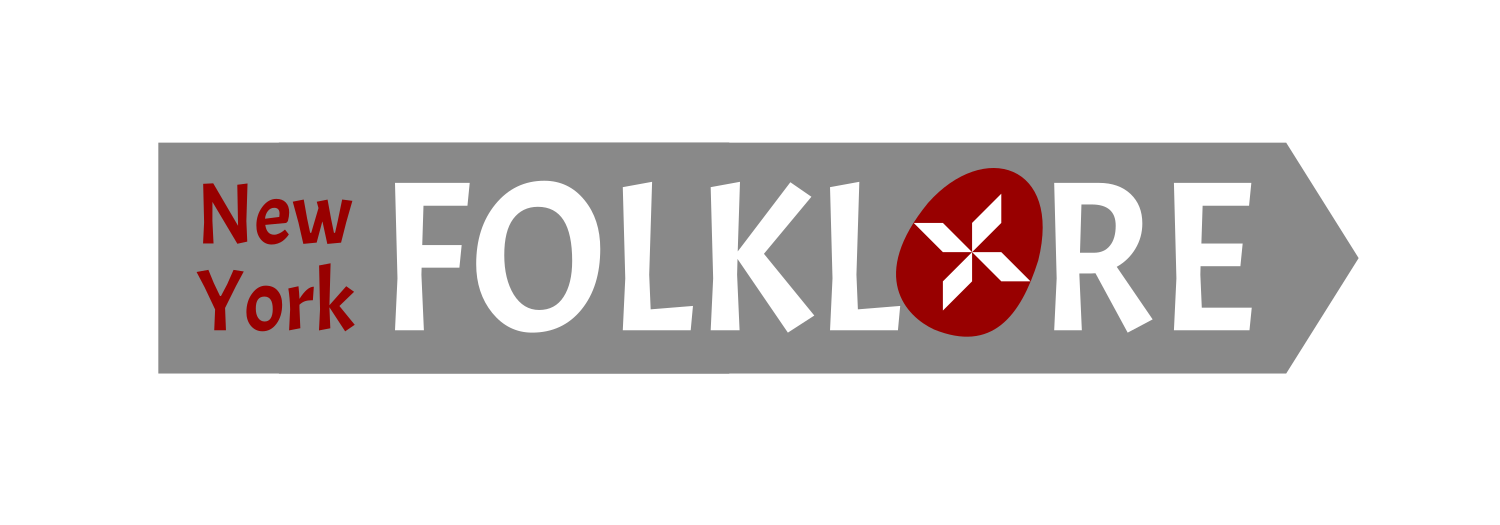This blog post is courtesy of New York Folklore Board Member and Arab Artist, Nada Odeh. Learn more about Nada and her work on her website https://www.nadaodeh.com.
Arabic Heritage Month
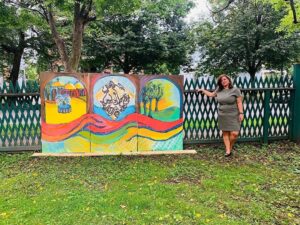
Nada Odeh standing in front of her traveling mural, Arabic words translates into:” If you don’t struggle that means your dream isn’t big enough” The Seward House Museum, Auburn, New York 2022.
One of the things that I like to celebrate as an Arab is Arabic calligraphy, folklore art and food. Visiting places like Dearborn in Michigan, Paterson in New Jersey, Little Syria in Manhattan or some Arabic areas in Brooklyn and Queens in New York city brings back the memories of experiences that I used to have living in Arab countries or where I call home. The Arab Americans in New York state are considered a large population but many try to melt into the pot because of current social, and political reasons. This April is National Arab American Heritage Month. It celebrates the Arab American heritage and culture and pays tribute to the contributions of Arab Americans and Arabic-speaking Americans
Arab Americans in New York State
According to federal statistics Arabs or Middle Eastern North Africans are not considered a minority group and because of this, reporting numbers are almost never exact. Reports of the population of Arab Americans are estimated from 160,000 in New York City alone to 405,000 in the state with adjustment for underreporting. Arab-American immigrants who came to the New York area can be traced back to two distinct waves of immigration from the Arab world. The early Syrian immigrants during the 1870s and the 1920s settled on Washington Street, Manhattan’s Little Syria, and were bankers, publishers, peddlers, manufacturers and importers of lace, linen, embroideries and lingerie. The second wave of immigration occurred after 1965 with the change of immigration laws. “Little Syria ” moved to Atlantic Avenue in Brooklyn once the immigrants became more affluent.
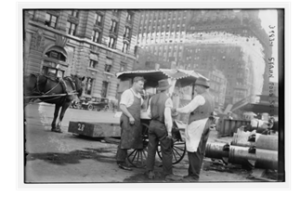
“Little Syria” Syrian food seller between ca. 1915 and ca. 1920, credit: Library of Congress
There, they started organizations and businesses. These immigrants were mostly Syrian Christians – Maronite, Melchite, and Syrian Orthodox – and Syrian Jews. In New York, Lebanese and Syrian Americans comprise 40% of the Arab-American community. Artists like Omar Offendum portrayed the historical event in his performance “Little Syria”. Offendum uses music to tell the story of the Little Syria neighborhood of Manhattan, which flourished in the late 19th and early 20th century, before many of its residents were displaced by construction and left for Brooklyn.
Arabic Art
Arabs who immigrated to the United States and New York were also artists, writers, poets, designers and more. One of the most famous Arab immigrants between 1890 and 1920 is Lebanese/ Syrian American poet and visual artist, Kahlil Gibran, author of “The Prophet.”
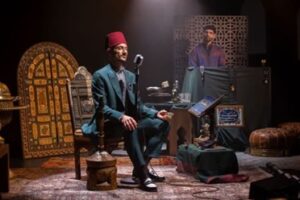
Syrian American rapper and singer Omar Offendum performing his show” Little Syria” in NYC Photo credit: Ridwan Adhami
He wrote the following poem to his Arab American compatriots, the majority of whom came from the land known as “Greater Syria” in Gibran’s time, which comprised today’s Syria, Lebanon, and Palestine/ Israel.
TO YOUNG AMERICANS OF SYRIAN ORIGIN
By Kahlil Gibran
“And what is it to be a good citizen? It is to be proud of being an American, but it is also to be proud that your fathers and mothers came from a land upon which God laid His gracious hand and raised His messengers. Young Americans of Syrian origin, I believe in you.”
While poetry is one of the most important forms of art in Arabic culture alongside came Arabic calligraphy. Arabic Calligraphy as an art form appears on both religious and secular objects in virtually every medium—architecture, paper, ceramics, carpets, glass, jewelry, woodcarving, and metalwork. In addition to its decorative qualities, it often provides valuable information about the object it decorates, such as function, maker, patron, and date and place of production. A number of factors, such as the prospective audience, content of the text, and the shape and function of an object, informs the type of script employed. Arabic calligraphy can include poetry, verses of Qur’an or parts from the Arabic Bible. Today Arabic calligraphy can be a representation of identity and culture and can include quotes, or religious verse and can be included in different forms, either two dimensional or three dimensional.
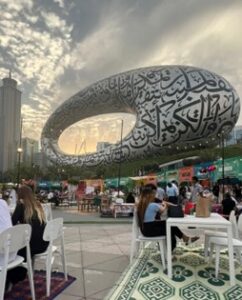
Arabic calligraphy at the Museum of the Future, Ramadan in Dubai, UAE i, 2023. Photo credit: Jude Kanawati.
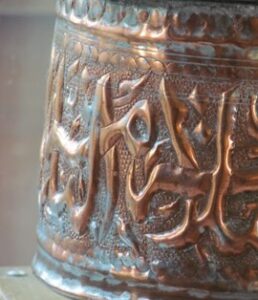
Copper vase engraved with Arabic calligraphy, Damascus made, Damascus Syria. Photo credit: Noura Charaf. Ca 2012
Resources
https://www.arabamerica.com/https://www.arabamerica.com/
https://www.metmuseum.org/learn/educators/curriculum-resources/art-of-the-islamic-world/~/media/Files/Learn/For%20Educators/Publications%20for%20Educators/Islamic%20Teacher%20Resource/Unit2.pdf
https://www.state.gov/dipnote-u-s-department-of-state-official-blog/the-story-of-arab-americans-beginning-in-america-and-the-quest-for-fair-representation/
